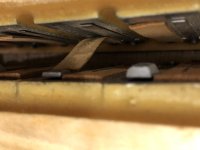AlicePalace
Member
I took a peek in my little Giulietti 26/48 today to give the bellows a little vinegar/alcohol wipe down (it’s a bit musty) and inspect whether there were any obvious reed issues. Happily there is no rust or anything, but I did find a leather valve in the bass that seems to be permanently curled. No matter which orientation I held it in, it still was curled (did not relax back into place). Can it be relaxed somehow? Does it matter? Could this be the reason for the occasional “raspberry” (pbththththt) noise I get when playing certain bass fundamental notes? Also, the leather was missing entirely on the highest treble note. Does it matter? The note seems to play just fine. Thanks for any advice you can give!



